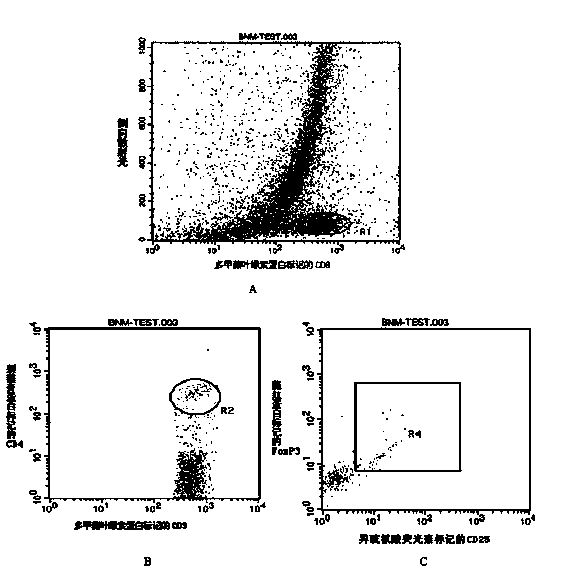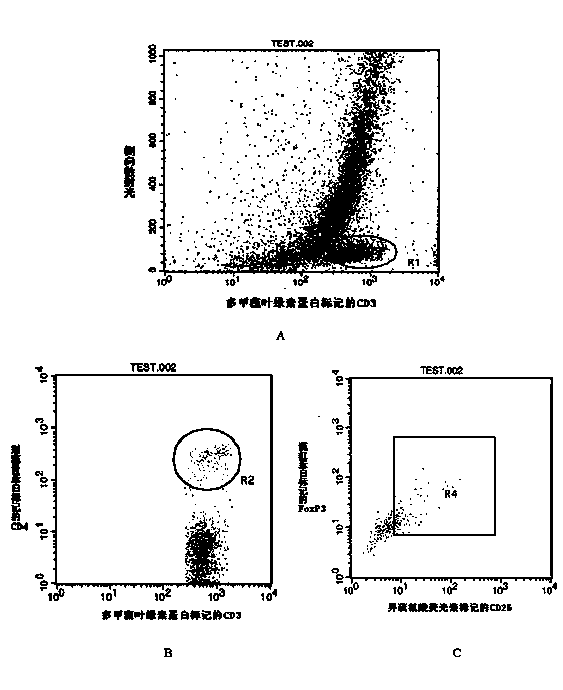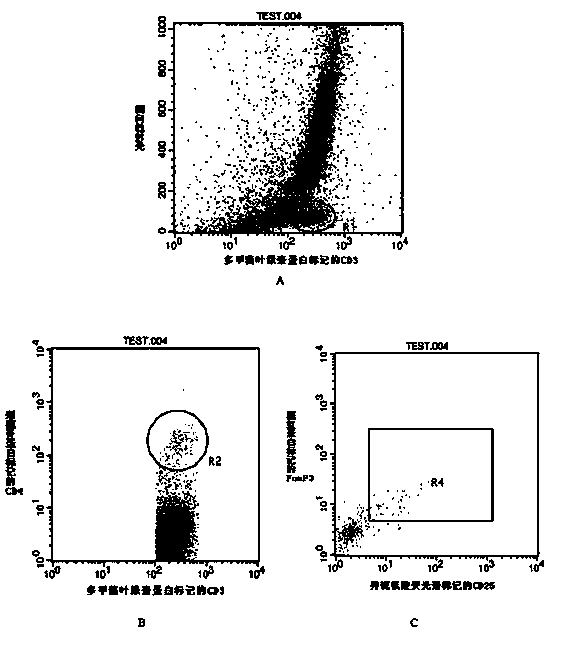Method for detecting regulatory T lymphocytes of human nasal mucosa
A technology for lymphocytes and nasal mucosa, applied in the field of biomedicine, can solve the problems such as the inability to directly react the Foxp3 protein of Treg cells, the inability to directly react to Treg cells, the complicated technical steps, etc., and achieve simple acquisition, simple and fast sample processing, and simple determination methods. Easy to operate effect
- Summary
- Abstract
- Description
- Claims
- Application Information
AI Technical Summary
Problems solved by technology
Method used
Image
Examples
preparation example Construction
[0062] (2) Preparation of single-cell suspension: Put the nasal mucosa into 1ml of normal saline, and blow gently with a pipette to disperse the cells evenly. Centrifuge at 5000rpm for 10 minutes, discard the supernatant, resuspend the pellet with 200ul PBS, and count.
[0063] (3) Regulatory T cell (Foxp3) detection (BD Pharmingen, CA, USA)
[0064] Reagent preparation: Buffer A and Buffer C are freshly prepared before use
[0065] 1× Human Foxp3 Buffer A: Dilute 10× Human Foxp3 Buffer A with deionized water to 1× working concentration.
[0066] Preparation of Working Solution Human Foxp3 Buffer C: Mix Foxp3 Buffer B with 1×Human Foxp3 Buffer A at a ratio of 1:50.
[0067] 1) Surface staining: Add 100ul cells (about 1×105 cells) to a 12×75 mm flow tube, and add cell surface staining antibodies.
[0068] Isotype control tube: CD3-PerCP 5ul + CD4-APC 2ul + IgG1-FITC 5ul
[0069] Test tube: CD3-PerCP 5ul + CD4-APC 2ul + CD25-FITC 5ul; Vortex the two tubes at room tempe...
Embodiment
[0078] Detection of Treg cells in nasal mucosa of patients with allergic rhinitis and normal people.
[0079] (1) Diagnosis and source of patients with allergic rhinitis
[0080] Allergic rhinitis patients were from outpatients of our hospital, and the diagnosis was in accordance with the "Diagnostic Criteria and Treatment Guidelines for Allergic Rhinitis" formulated by the Otolaryngology-Head and Neck Surgery Branch of the Chinese Medical Association. Exclusions included patients with chronic rhinosinusitis and nasal polyps, severe deviated nasal septum, and other chronic heart, lung, and endocrine dysfunction. Normal people come from the medical examiners of our hospital.
[0081] (2) Detection of Treg cells
[0082] Use a nasal mucosal curette to scrape off the nasal mucosa at the lower and middle end of the lower turbinate, place in normal saline, blow and mix well, centrifuge, discard the supernatant, obtain cell pellets, and count. Label CD3, CD4, and CD25 on the cell...
PUM
 Login to View More
Login to View More Abstract
Description
Claims
Application Information
 Login to View More
Login to View More - R&D
- Intellectual Property
- Life Sciences
- Materials
- Tech Scout
- Unparalleled Data Quality
- Higher Quality Content
- 60% Fewer Hallucinations
Browse by: Latest US Patents, China's latest patents, Technical Efficacy Thesaurus, Application Domain, Technology Topic, Popular Technical Reports.
© 2025 PatSnap. All rights reserved.Legal|Privacy policy|Modern Slavery Act Transparency Statement|Sitemap|About US| Contact US: help@patsnap.com



